MatPlotLib is innate Python
Table of Contents
GNU Octave meets Python
Data importing
import numpy as np import scipy.io def read_dataset(filename): """Reads data from .mat binary file.""" data = scipy.io.loadmat(filename) return [data[k] for k in ('neg_examples_nobias', 'pos_examples_nobias', 'w_init', 'w_gen_feas')]
(nen, pen, wi, wg) = read_dataset('data/dataset1.mat') print(nen, '\n\n', pen, '\n\n', wi, '\n\n', wg) print(type(nen))
[[-0.80857143 0.8372093 ] [ 0.35714286 0.85049834] [-0.75142857 -0.73089701] [-0.3 0.12624585]] [[ 0.87142857 0.62458472] [-0.02 -0.92358804] [ 0.36285714 -0.31893688] [ 0.88857143 -0.87043189]] [[-0.62170147] [ 0.76091527] [ 0.77187205]] [[ 4.3496526 ] [-2.60997235] [-0.69414749]] <class 'numpy.ndarray'>
NdArray manipulations
Directly
for i in nen: print(i[0], i[1], type(i[1]), '\n')
... -0.808571428571 0.837209302326 <class 'numpy.float64'> 0.357142857143 0.85049833887 <class 'numpy.float64'> -0.751428571429 -0.730897009967 <class 'numpy.float64'> -0.3 0.126245847176 <class 'numpy.float64'>
Converted
for i in nen.tolist(): print(i[0], i[1], type(i[1]), '\n')
... -0.8085714285714286 0.8372093023255818 <class 'float'> 0.3571428571428572 0.8504983388704321 <class 'float'> -0.7514285714285714 -0.7308970099667773 <class 'float'> -0.2999999999999999 0.1262458471760799 <class 'float'>
Data visualization
Simple
import matplotlib.pyplot as plt plt.plot([1,2,3,4], [1,4,9,16], 'ro') plt.axis([0, 6, 0, 20]) plt.savefig('img/plt/first_test.png')
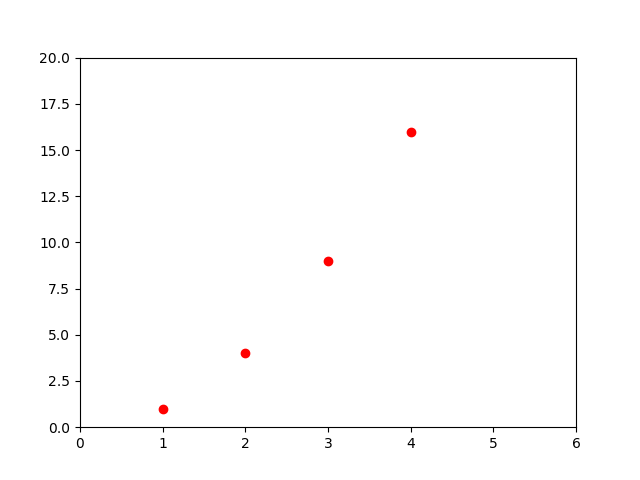
Colorization
ax = plt.gca() ax.set_axis_bgcolor('black') # ax.set_axis_bgcolor((1, 0, 0)) plt.plot([1,2,3,4], [1,4,9,16], 'b^') plt.axis([0, 6, 0, 20]) plt.savefig('img/plt/second_test.png')
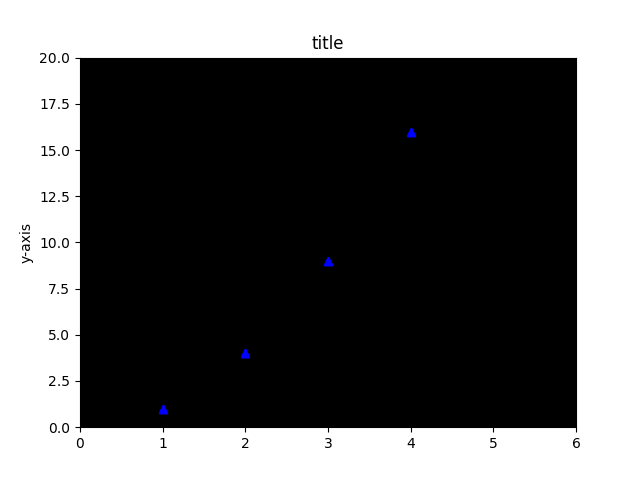
Full-fledged dark theme
import numpy as np import matplotlib.pyplot as plt plt.style.use('dark_background') fig, ax = plt.subplots() L = 6 x = np.linspace(0, L) ncolors = len(plt.rcParams['axes.prop_cycle']) shift = np.linspace(0, L, ncolors, endpoint=False) for s in shift: ax.plot(x, np.sin(x + s), 'o-') ax.set_xlabel('x-axis') ax.set_ylabel('y-axis') ax.set_title("'dark_background' style sheet") plt.savefig('img/plt/dark_test.png')
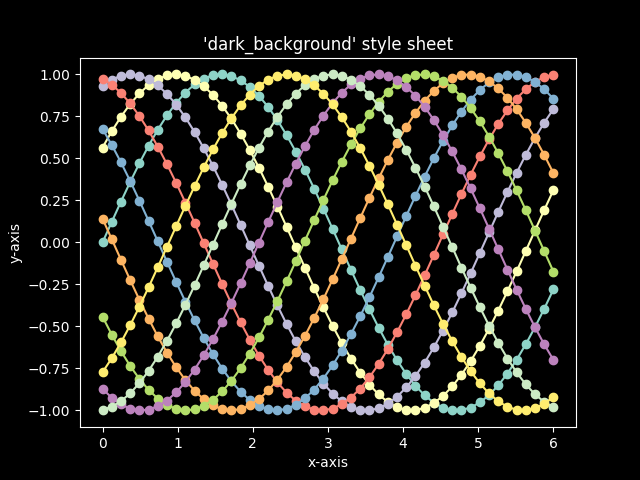
Scattering
import matplotlib.pyplot as plt plt.style.use('dark_background') x = [1, 2, 3, 4, 5] y = [6, 7, 8, 9, 11] plt.scatter(x, y, color='y') plt.xlabel('x') plt.ylabel('y') plt.title('Simple scattering') plt.savefig('img/plt/simple_scatter.png')
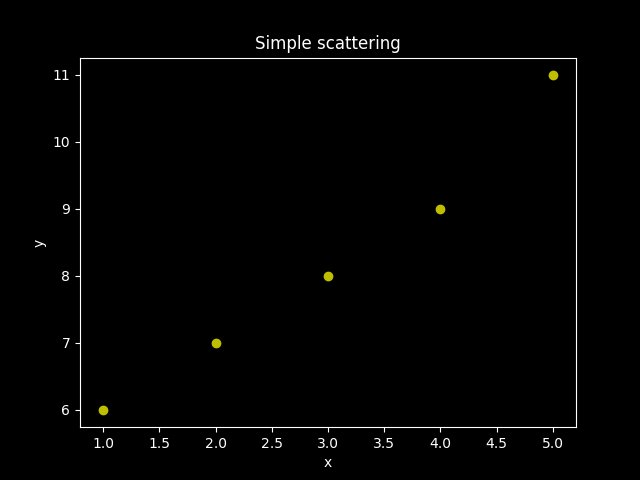
All together
import matplotlib.pyplot as plt plt.style.use('dark_background') data_neg = [[-0.80857143, 0.8372093], [ 0.35714286, 0.85049834], [-0.75142857, -0.73089701], [-0.3, 0.12624585]] data_pos = [[0.87142857, 0.62458472], [-0.02, -0.92358804], [0.36285714, -0.31893688], [ 0.88857143, -0.87043189]] for i in data_neg: plt.scatter(i[0], i[1], color='y') for i in data_pos: plt.scatter(i[0], i[1], color='r') plt.xlabel('x') plt.ylabel('y') plt.title('Data scattering') plt.savefig('img/plt/data_scatter.png')
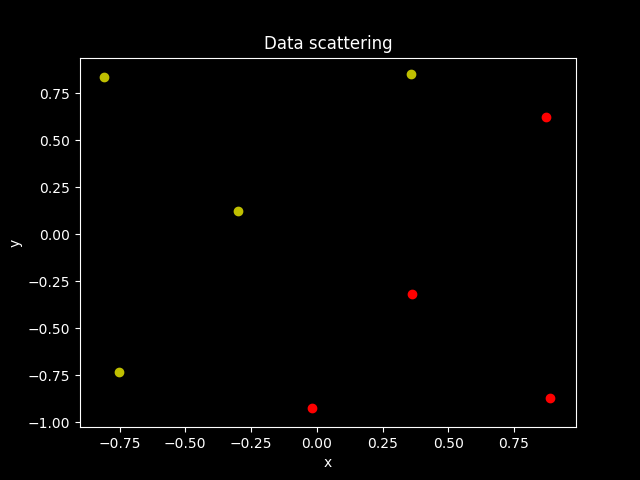
Parabola
import numpy as np from math import exp import matplotlib.pyplot as plt def custom_function(x): # sigmoid(x): return x * x # 1. / (1 + exp(-x)) x = np.array(range(-10, 11)) y = custom_function(x) #sigmoid(x) plt.style.use('dark_background') plt.plot(x, y) plt.savefig('img/plt/sigmoidal_f.png')
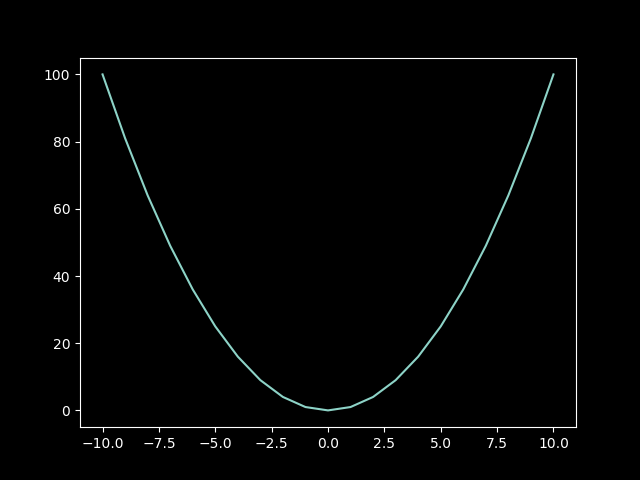
Four datasets on one picture
Iterate the dataset
datasets = ['data/dataset1.mat', 'data/dataset2.mat', 'data/dataset3.mat', 'data/dataset4.mat'] for i in datasets: (nen, pen, wi, wg) = read_dataset(i) print(nen, '\n\n', pen, '\n\n', wi, '\n\n', wg) print('\n\n\n')
>>> ... ... ... ... [[-0.80857143 0.8372093 ] [ 0.35714286 0.85049834] [-0.75142857 -0.73089701] [-0.3 0.12624585]] [[ 0.87142857 0.62458472] [-0.02 -0.92358804] [ 0.36285714 -0.31893688] [ 0.88857143 -0.87043189]] [[-0.62170147] [ 0.76091527] [ 0.77187205]] [[ 4.3496526 ] [-2.60997235] [-0.69414749]] [[-0.80857143 0.8372093 ] [ 0.35714286 0.85049834] [-0.75142857 -0.73089701] [-0.3 0.12624585] [ 0.64285714 -0.5448505 ]] [[ 0.87142857 0.62458472] [-0.02 -0.92358804] [ 0.36285714 -0.31893688] [ 0.88857143 -0.87043189] [-0.52857143 0.51162791]] [[ 1.84689887] [-0.58324929] [-0.54178883]] [] [[-0.79142857 0.07973422] [-0.55714286 0.41196013] [-0.22571429 0.69767442] [ 0.16285714 0.83056478] [ 0.46 0.65780731] [ 0.73428571 0.33887043] [ 0.82571429 -0.01328904]] [[-0.76285714 -0.19269103] [-0.60285714 -0.48504983] [-0.38571429 -0.69767442] [-0.19142857 -0.35880399] [ 0.28285714 -0.43189369] [ 0.40857143 -0.69767442] [ 0.75142857 -0.23255814]] [[ 0.90368034] [-0.49087549] [ 0.94855295]] [[ -0.67272864] [-11.48921717] [ -0.89411095]] [[-0.86571429 -0.39202658] [-0.78571429 -0.17275748] [-0.55714286 0.24584718] [-0.28857143 0.52491694] [-0.12857143 0.52491694] [ 0.08285714 0.33222591] [ 0.18 0.10631229] [ 0.25428571 -0.16611296] [ 0.32857143 -0.35215947]] [[-0.08857143 0.23255814] [ 0.00857143 -0.06644518] [ 0.12857143 -0.3255814 ] [ 0.28857143 -0.52491694] [ 0.59714286 -0.46511628] [ 0.71714286 -0.1461794 ] [ 0.86 0.15946844] [ 0.94571429 0.44518272]] [[-0.03182596] [-0.25511273] [-0.00710252]] []
Scatter NumPy array
import matplotlib.pyplot as plt plt.style.use('dark_background') (data_neg, data_pos, wi, wg) = read_dataset('data/dataset1.mat') for i in data_neg: plt.scatter(i[0], i[1], color='y') for i in data_pos: plt.scatter(i[0], i[1], color='r') plt.xlabel('x') plt.ylabel('y') plt.title('NumPy scattering') plt.savefig('img/plt/ndarray_scatter.png')
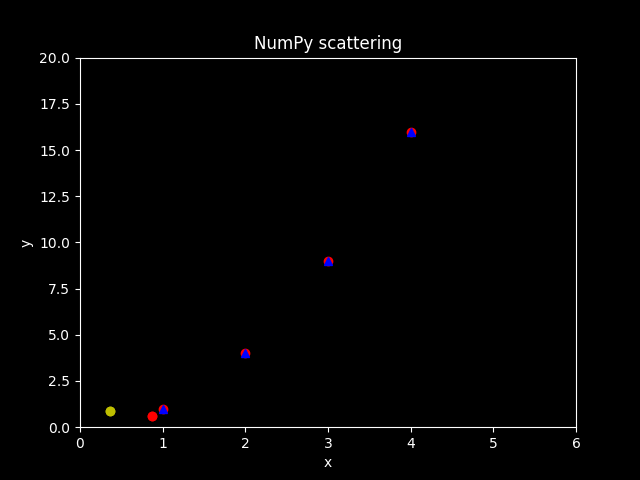
Scatter several datasets on one image
import scipy.io import matplotlib.pyplot as plt def read_dataset(filename): """Reads data from .mat binary file.""" data = scipy.io.loadmat(filename) return [data[k] for k in ('neg_examples_nobias', 'pos_examples_nobias', 'w_init', 'w_gen_feas')] datasets = ['data/dataset1.mat', 'data/dataset2.mat', 'data/dataset3.mat', 'data/dataset4.mat'] plt.style.use('dark_background') fig = plt.figure() for i, data in enumerate(datasets): (data_neg, data_pos, wi, wg) = read_dataset(data) s1 = fig.add_subplot(2, 2, i+1) for i in data_neg: s1.scatter(i[0], i[1], color='y') for i in data_pos: s1.scatter(i[0], i[1], color='r') plt.savefig('img/plt/four_datasets.png')
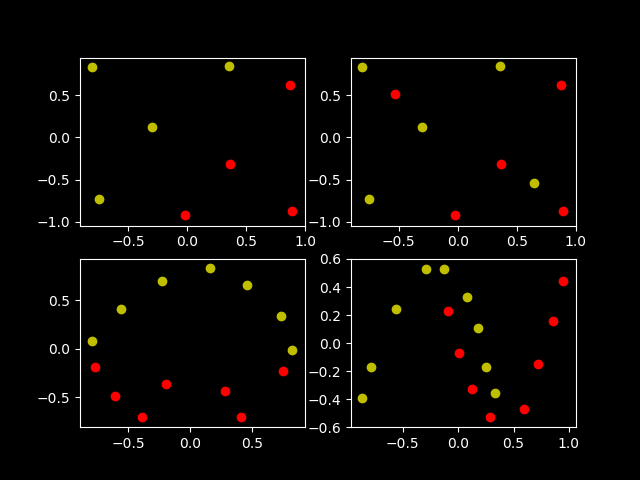
blog comments powered by Disqus